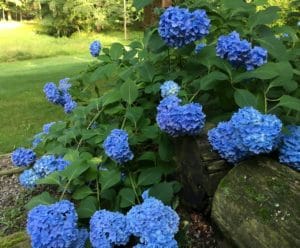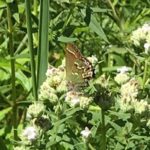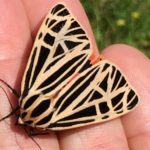Hello fellow readers, An invitation to a pool party inspired gathering flowers from the garden to bring to the hosts. One of the lovelies, Mountain Mint, reminds me of a walk in the meadow with my birder buddy and naturalist I look forward to sharing with you.

Year two after Curt’s “unintentional” rejuvenation pruning.
Voluptuous Hydrangea Flowers
The bouquet featured robust hydrangea flowers – a gorgeous deep bluish purple. They are the same hydrangeas Curt kindheartedly pruned close to the ground in early spring a handful of years ago. He confused them with the Butterfly Bush I asked him to cut back as they benefit from rejuvenation pruning each spring. After two summers with no flowers, our hydrangeas that bloom on old wood (planted by the previous owners) rebounded to be profuse bloomers.
Puffs Queen Anne’s Lace

A snagged a few cuttings of Queen Anne’s Lace.
I snagged a few Queen Anne’s Lace along the road while walking Jolee, leaving plenty for pollinators. Daucus carota is also called Wild Carrot. Today’s edible carrots were cultivated from Queen Anne’s Lace, also a companion plant to crops. They can boost tomato plant production when kept nearby and provides a microclimate of cooler, moister air for lettuce when intercropped.
On the other hand, the USDA has listed Queen Anne’s Lace as a pest in pastures as its seeds persist for two to five years. Yet beneficial bugs such as caterpillars of the Eastern Black Swallowtail butterfly eat the leaves, and pollinators drink the nectar.

Wasps are pollinators, too, enjoying Short-toothed Mountain Mint
Plus, Short-toothed Mountain Mint
When we returned home, I clipped stems of my Short-toothed mountain mint (Pycnanthemum muticum), now flourishing in a swath below a spot where two stately hemlocks once stood. Its silvery bracts are showy below demure pinkish flowers. The bountiful bees and butterflies dancing from July to September make the best of the show.
A sidenote on flower bracts—They are modified leaves that Mother Nature created just below the flowers to help protect the budding flower and attract pollinators. Most know the red leaves on poinsettias are bracts, and their flowers are the tiny yellow bud-like things in the center. The same is true of the lovely white and pink display of Dogwood trees in spring.
Short-toothed mountain mint grows about two to three feet tall with multiple stems. It’s happy living along a woodland’s edge or in meadows. Speaking of them brings memories of special walks with my friend and go-to mystery solver of critters and plants. Dennis nurtures nature with glorious fields surrounding his home in Blairstown, NJ.

Dennis’s Meadow
The Gift of Magnificent Meadow Plants
As we meander the paths, among the meadow are thriving native perennials loved by pollinators and songbirds, and most are highly deer resistant. There’s Goldenrod (Solidago) with masses of bright golden flowers. Blazing Stars (Liatris) with spikey rose-purple flowers rising above its grassy foliage. Plus Beebalm, aka Bergamot (Monarda) with puffy mops of light purple flowers. And the classic sunny yellow native Black-eyed Susan (Rudbeckia hirta) mixed with Coneflowers (Echinacea purpurea) with lavender petals and orange-brown centers. It’s the same echinacea used to make herbal tea or supplements to strengthen the immune system.
Other Varieties of Mountain Mint – Magnets for Pollinators
Dennis’s narrow-leaved Mountain Mint (Pycnanthemum tenuifolium) and Virginia mountain mint (P. virginianum) are different varieties than mine, creating clouds of white flowers in waves throughout the meadow.

Juniper Hairstreak Butterfly (Callophrys gryneus)
His enthusiasm with coming upon three Juniper Hairstreak Butterflies (Callophrys gryneus) was contagious. I had to look closely to appreciate the ornate green, taupe with white streak details of this rare to see petite beauty with only an inch wingspan. The next day he recorded sixteen juniper hairstreaks in a two-hour butterfly survey during which he found twenty butterfly species. “A very productive day.”

Virgin Tiger Moth

Quite a fashion statement!
My favorite marvel during a walk was a virgin tiger moth, Grammia virgo. When her wings are closed, she’s a beautiful light beige with black zebra stripes. When she opens her two-inch wingspan, red with black polka dots reveals. Quite a fashion statement that will hopefully never go out of style. Garden Dilemmas? AskMaryStone@gmail.com and your favorite Podcast App.
You’ll enjoy more of the story in Episode 68 of the Garden Dilemmas Podcast
Links to related stories:


